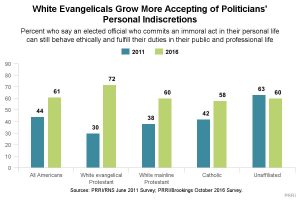Jonathan Haidt, a social psychologist at the University of Virginia, is making quite a splash. In January he set off a media storm by chastising his fellow psychologists for liberal bias. As the New York Times recently reported, he told the annual meeting of the Society for Personality and Social Psychology that its members “are a ‘tribal-moral community’ united by ‘sacred values’ that hinder research and damage their credibility.”
But that was just the most recent move in Haidt’s ongoing campaign to persuade American liberals in every walk of life that they’re hampered by anti-conservative bias. He wants liberals to understand conservatives more accurately, and perhaps even sympathetically.
I certainly applaud any effort to understand the right better. And I agree with Haidt that understanding has to begin with accurate description. As a historian of religions I was trained to practice what we called phenomenological “epoche”: suspending judgment, understanding the people we’re studying in and on their own terms, trying our best to see the world through their eyes.
It may be an old-fashioned methodology in religious studies, but it’s still a good tool for liberals to use in understanding their opponents—as long as it’s followed by efforts to explain the phenomena.
That’s the first big problem with Haidt’s work. He goes no further than describing how the world looks through conservative eyes, so he tells us little that we didn’t already know. That description, summed up in his “Moral Foundations Theory,” does have the virtue of simplicity. Liberals have two basic values, he claims: treating everyone fairly, and preventing or mitigating harm. That’s because liberals view society as nothing more than a collection of discrete individuals, each of whom should have their life, liberty, and human rights protected from others.
Conservatives share those moral values but add three more: in-group loyalty, respect for authority, and purity/sanctity. That’s because (again, á la Haidt) conservatives see the social group as having a life of its own, beyond the lives of its individual members. So conservatives want to sustain and nurture the well-being of the group too.
I suggested to Haidt, via email, that he was merely trying to describe the differences between the two groups’ views, but he demurred. As a scientist, he claimed, he is in quest of explanation. And he does not accept a common explanatory theory, which sees conservatives as motivated by non-moral factors like death anxiety, needs for structure and closure, intolerance of ambiguity and uncertainty, and fear of threat or loss.
He thinks his empirical findings point to a better explanation of the evidence as to why many people are conservative: they want to be moral people, and they believe that loyalty, authority, and purity are moral goods, just as important as fairness and harm-prevention.
He sometimes offers his own substantive arguments for what he sees as the group-enhancing effects of conservative values. Though by temperament a liberal and a democrat, he told me, his research has led him to find at least as much merit in conservative ideas as in liberal ones.
But his research offers no evidence that most conservatives share his substantive arguments. His data show only that conservatives put the three sets of group-oriented values in the category of “moral values.” On that basis alone, he tells liberals to stop looking for other explanations of conservatism, because conservatives are motivated purely by moral concerns.
Of course this is circular reasoning. It’s like saying that lots of people prefer chocolate candy simply because they think it’s chocolatey. It’s fine as description, but it doesn’t really explain anything.
What’s more, it deems conservative values to be truly moral values simply because conservatives say so. By that reasoning, are we not obligated to regard any behavior as moral as long as some group calls it moral—a slippery slope, to say the least. (I will leave readers to supply their own examples of how this verbal game has been played to justify immorality too often in the past and present.)
Fear of the Mob
To bolster his argument, Haidt invokes the work of the great French sociologist Emile Durkheim. When he first read Durkheim, he had what he calls “an experience of enlightenment”: Societies are “emergent organisms,” not just aggregates of individuals. Therefore group-oriented values are moral values.
Haidt thinks more psychologists should read the great sociological theorists—to which one can only say, amen. But will they, or Haidt himself, read Durkheim in historical context? Though the father of sociology may have tried as hard as the rest of us to be value-free, he was no more successful. He prized group values because he was a creature of his times.
Durkheim was a Jew, an exact contemporary of the Jewish officer Alfred Dreyfus, who was so terribly victimized by French anti-Semitism. Durkheim, who was understandably concerned about whether the Jews would ever be accepted as an integral part of French society, wanted to be sure there could be no doubts about his own loyalty to France as his primary group identity. Having grown up in a society still powerfully shaped by romantic nationalism, he devoted much of his career to developing curricula and pedagogical techniques that would inculcate a powerful sense of group identity and loyalty in French schoolchildren.
Yet, as a child of the Enlightenment he was devoted to science, and thus to independence of mind. Seeing clearly the dangerous excesses of nationalism he struggled to develop a social and educational theory that could harmonize maximum individual freedom with maximum social solidarity.
Durkheim was also in the intellectual elite, dedicated like all his colleagues to cultivating the most refined bourgeois values. Yet as an advocate of individual freedom and as a Jew with relatively newly-minted political rights, he also had to promote the democracy of the Third Republic against its ultra-nationalist conservative critics. Of course democracy could so easily lead to laws and values dictated by the masses—the same rude mobs calling for Dreyfus’ blood in the streets of Paris.
How, then, to harmonize free thought with devotion to the highest moral values? Again, education was the answer—schools that taught respect for both the scientific method and the traditional virtues.
Intellectual historians have well explained why Durkheim would choose to emphasize all five of the moral values Jonathan Haidt studies. And those historians can tell us why Durkheim saw an inherent conflict between individual and social goods. That way of seeing life is not at all universal (as Haidt, so deeply influenced by anthropology, would surely agree). It emerges from particular cultural-historical circumstances.
Ultimately, Haidt can’t offer any real explanation of conservatism because he fails to factor in cultural-historical situation. So he doesn’t tell us what we really want to know: Why do today’s conservatives, like Durkheim, worry so much about a supposed conflict between individual and group well-being? Why, as his research data shows, are conservatives less likely than liberals to emphasize the values of fairness and harm-prevention? Why do conservatives give relatively more weight to those three group-oriented values when they decide moral issues?
Conservative bogeyman: “The ’60s”
To look for some plausible explanatory answers, I would turn to the truest spokesman for today’s brand of conservatism: Irving Kristol. In the footsteps of Durkheim, Kristol expressed fear that the mob would run wild if not reined in by an internalized respect for the group, its leaders, and its traditional notions of moral purity.
Why did Kristol feel so afraid? He offered plenty of intellectual answers, all revolving around the idea that evil is innate in human nature. Though he, like Durkheim, was Jewish, he had “no problem,” he wrote, with the Christian doctrine of Original Sin.
As with Durkheim, though, the deeper answer lies in historical context. Kristol was, as he famously said, “a liberal mugged by reality.” And he identified the very specific reality that mugged him: the unexpected rise of the 1960s counterculture. He described it at the time as “a prescription for moral anarchy, which is exactly what we are now experiencing… The idea of ordered liberty could collapse,” leaving only “freedom, confusion, and disorientation, all embellished with a veneer of ‘equality.’” Spoken like a true conservative, neo- or otherwise.
Modern conservatism has produced a whole troop of articulate thinkers eager to create a sophisticated intellectual frame for this fear-ridden view. But the project got its energy, and its votes, from widespread inchoate fear of what looked to many like chaos and anarchy in the 1960s. The conservatism of the ’60s and beyond followed Durkheim (though only the intellectuals knew it) in assuming that there was an inherent conflict between individual freedom and group well-being, between true democracy and the highest moral values.
Why should we make those assumptions? Or, more precisely: Who would make those assumptions? There is a mass of research (which Haidt rejects, as noted above) to demonstrate the answer quite empirically: people who are afraid of rapid change, which they interpret as a threat of loss, because it brings ambiguity and uncertainty, undermining the fixed structures and boundaries that they hope will offer the security of closure.
Security and closure are always illusions, the counterculture of the ’60s insisted, a thought that remains simply too frightening for many Americans to bear. So they go on, as Bernard von Bothmer has shown, mounting political campaigns against their distorted image of “the ’60s.”
Though that perpetuates their anxiety, it also gives them the paradoxically reassuring feeling that they are resisting change—even when change is desperately needed to improve the well-being of the entire society. Liberals, on the other hand, have a more open-ended worldview and are thus more accepting of change—not just for themselves but for the whole society.
Which brings us to the most glaring flaw in Haidt’s basic “Moral Foundations Theory.” It glibly assumes that liberals are so concerned about fairness and harm-prevention only because they want their own personal well-being protected, that they don’t care about the well-being of the society as conservatives do.
This is a case of seeing the philosophical trees but missing the forest of actual life. Sure, there’s a long history of liberal theory based on individual rights. But when you talk to real live liberals today, it’s immediately obvious that most of them are moved by a deep concern for improving the social (and natural) environment.
It’s the liberals, not the conservatives, who are quick to quote Martin Luther King Jr.’s famous dictum that we are all bound together in a single garment of destiny. It’s the liberals who are willing to spend what it takes to create “The Great Society,” to fight a war on poverty even though most of them are far from poor; to make sure everyone has affordable medical care, even though most liberals already have employer-paid medical insurance, etc., etc.
Conservatives’ concern for the group is narrower, expressed in very few channels. Their favored policies tend to assume that American society will do just fine with 20% of our children growing up in poverty and nearly the same percentage of adults without affordable health care, as long as we arm ourselves against some foreign enemy or other (in-group loyalty), live by the same social norms as our grandparents (respect for authority), and keep our zippers firmly zipped until we’re married (purity/sanctity). A very selective interpretation of group well-being, to say the least.
These examples point to the crucial difference between the two groups. Liberals see less inherent conflict between individual and group well-being than conservatives do, because liberals, less persuaded by the notion of Original Sin, are less afraid of change. They want to improve the whole society with these changes. Conservatives, more afraid of human nature itself, assume that the only way to improve society is by preventing change.
If Haidt urged us to understand better the anxieties and insecurities that drive conservatives, I’d be the first to applaud. That’s a woefully neglected issue in liberal political life. But the danger in Haidt’s work is that it blinds us to explanatory understandings of conservatism.
Finally, what about those who, like Dr. King, see no inherent conflict between individual and society? Today they’re called progressives; to the left of liberals, they are the true heirs of ’60s radicalism. It’s a shame that Haidt limits his study to the two overly-neat categories of liberal and conservative—not only because most Americans don’t fit into those pigeonholes, but because he makes no room for progressives.
Progressives assume that whatever is good for one is good for all (and vice versa), and they have more trust that human nature allows us to pursue individual and group good at the same time. If Haidt is to become the media’s favorite guide to conservatism, he would do well to widen his view to see this other end of the political spectrum too.




